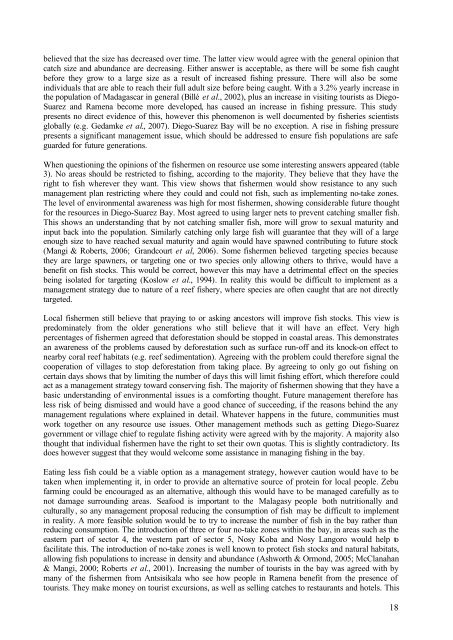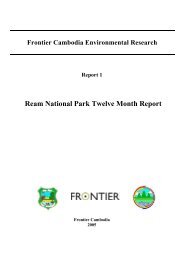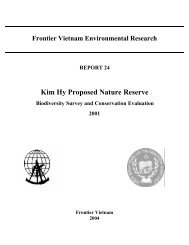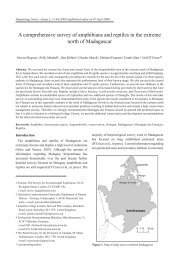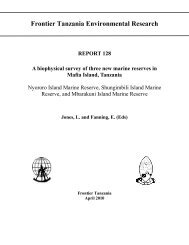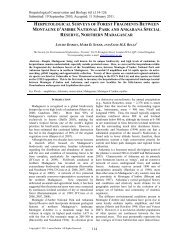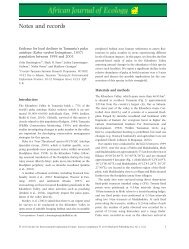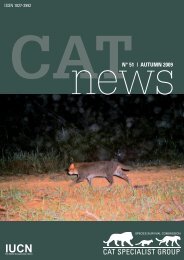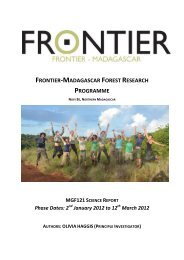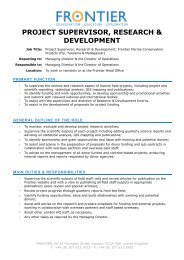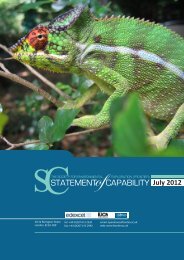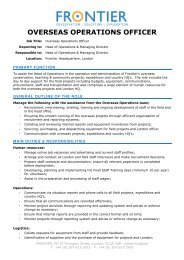An assessment of local fisheries in Diego-Suarez Bay, Madagascar
An assessment of local fisheries in Diego-Suarez Bay, Madagascar
An assessment of local fisheries in Diego-Suarez Bay, Madagascar
You also want an ePaper? Increase the reach of your titles
YUMPU automatically turns print PDFs into web optimized ePapers that Google loves.
elieved that the size has decreased over time. The latter view would agree with the general op<strong>in</strong>ion that<br />
catch size and abundance are decreas<strong>in</strong>g. Either answer is acceptable, as there will be some fish caught<br />
before they grow to a large size as a result <strong>of</strong> <strong>in</strong>creased fish<strong>in</strong>g pressure. There will also be some<br />
<strong>in</strong>dividuals that are able to reach their full adult size before be<strong>in</strong>g caught. With a 3.2% yearly <strong>in</strong>crease <strong>in</strong><br />
the population <strong>of</strong> <strong>Madagascar</strong> <strong>in</strong> general (Billé et al., 2002), plus an <strong>in</strong>crease <strong>in</strong> visit<strong>in</strong>g tourists as <strong>Diego</strong>-<br />
<strong>Suarez</strong> and Ramena become more developed, has caused an <strong>in</strong>crease <strong>in</strong> fish<strong>in</strong>g pressure. This study<br />
presents no direct evidence <strong>of</strong> this, however this phenomenon is well documented by <strong>fisheries</strong> scientists<br />
globally (e.g. Gedamke et al., 2007). <strong>Diego</strong>-<strong>Suarez</strong> <strong>Bay</strong> will be no exception. A rise <strong>in</strong> fish<strong>in</strong>g pressure<br />
presents a significant management issue, which should be addressed to ensure fish populations are safe<br />
guarded for future generations.<br />
When question<strong>in</strong>g the op<strong>in</strong>ions <strong>of</strong> the fishermen on resource use some <strong>in</strong>terest<strong>in</strong>g answers appeared (table<br />
3). No areas should be restricted to fish<strong>in</strong>g, accord<strong>in</strong>g to the majority. They believe that they have the<br />
right to fish wherever they want. This view shows that fishermen would show resistance to any such<br />
management plan restrict<strong>in</strong>g where they could and could not fish, such as implement<strong>in</strong>g no-take zones.<br />
The level <strong>of</strong> environmental awareness was high for most fishermen, show<strong>in</strong>g considerable future thought<br />
for the resources <strong>in</strong> <strong>Diego</strong>-<strong>Suarez</strong> <strong>Bay</strong>. Most agreed to us<strong>in</strong>g larger nets to prevent catch<strong>in</strong>g smaller fish.<br />
This shows an understand<strong>in</strong>g that by not catch<strong>in</strong>g smaller fish, more will grow to sexual maturity and<br />
<strong>in</strong>put back <strong>in</strong>to the population. Similarly catch<strong>in</strong>g only large fish will guarantee that they will <strong>of</strong> a large<br />
enough size to have reached sexual maturity and aga<strong>in</strong> would have spawned contribut<strong>in</strong>g to future stock<br />
(Mangi & Roberts, 2006; Grandcourt et al, 2006). Some fishermen believed target<strong>in</strong>g species because<br />
they are large spawners, or target<strong>in</strong>g one or two species only allow<strong>in</strong>g others to thrive, would have a<br />
benefit on fish stocks. This would be correct, however this may have a detrimental effect on the species<br />
be<strong>in</strong>g isolated for target<strong>in</strong>g (Koslow et al., 1994). In reality this would be difficult to implement as a<br />
management strategy due to nature <strong>of</strong> a reef fishery, where species are <strong>of</strong>ten caught that are not directly<br />
targeted.<br />
Local fishermen still believe that pray<strong>in</strong>g to or ask<strong>in</strong>g ancestors will improve fish stocks. This view is<br />
predom<strong>in</strong>ately from the older generations who still believe that it will have an effect. Very high<br />
percentages <strong>of</strong> fishermen agreed that deforestation should be stopped <strong>in</strong> coastal areas. This demonstrates<br />
an awareness <strong>of</strong> the problems caused by deforestation such as surface run-<strong>of</strong>f and its knock-on effect to<br />
nearby coral reef habitats (e.g. reef sedimentation). Agree<strong>in</strong>g with the problem could therefore signal the<br />
cooperation <strong>of</strong> villages to stop deforestation from tak<strong>in</strong>g place. By agree<strong>in</strong>g to only go out fish<strong>in</strong>g on<br />
certa<strong>in</strong> days shows that by limit<strong>in</strong>g the number <strong>of</strong> days this will limit fish<strong>in</strong>g effort, which therefore could<br />
act as a management strategy toward conserv<strong>in</strong>g fish. The majority <strong>of</strong> fishermen show<strong>in</strong>g that they have a<br />
basic understand<strong>in</strong>g <strong>of</strong> environmental issues is a comfort<strong>in</strong>g thought. Future management therefore has<br />
less risk <strong>of</strong> be<strong>in</strong>g dismissed and would have a good chance <strong>of</strong> succeed<strong>in</strong>g, if the reasons beh<strong>in</strong>d the any<br />
management regulations where expla<strong>in</strong>ed <strong>in</strong> detail. Whatever happens <strong>in</strong> the future, communities must<br />
work together on any resource use issues. Other management methods such as gett<strong>in</strong>g <strong>Diego</strong>-<strong>Suarez</strong><br />
government or village chief to regulate fish<strong>in</strong>g activity were agreed with by the majority. A majority also<br />
thought that <strong>in</strong>dividual fishermen have the right to set their own quotas. This is slightly contradictory. Its<br />
does however suggest that they would welcome some assistance <strong>in</strong> manag<strong>in</strong>g fish<strong>in</strong>g <strong>in</strong> the bay.<br />
Eat<strong>in</strong>g less fish could be a viable option as a management strategy, however caution would have to be<br />
taken when implement<strong>in</strong>g it, <strong>in</strong> order to provide an alternative source <strong>of</strong> prote<strong>in</strong> for <strong>local</strong> people. Zebu<br />
farm<strong>in</strong>g could be encouraged as an alternative, although this would have to be managed carefully as to<br />
not damage surround<strong>in</strong>g areas. Seafood is important to the Malagasy people both nutritionally and<br />
culturally, so any management proposal reduc<strong>in</strong>g the consumption <strong>of</strong> fish may be difficult to implement<br />
<strong>in</strong> reality. A more feasible solution would be to try to <strong>in</strong>crease the number <strong>of</strong> fish <strong>in</strong> the bay rather than<br />
reduc<strong>in</strong>g consumption. The <strong>in</strong>troduction <strong>of</strong> three or four no-take zones with<strong>in</strong> the bay, <strong>in</strong> areas such as the<br />
eastern part <strong>of</strong> sector 4, the western part <strong>of</strong> sector 5, Nosy Koba and Nosy Langoro would help to<br />
facilitate this. The <strong>in</strong>troduction <strong>of</strong> no-take zones is well known to protect fish stocks and natural habitats,<br />
allow<strong>in</strong>g fish populations to <strong>in</strong>crease <strong>in</strong> density and abundance (Ashworth & Ormond, 2005; McClanahan<br />
& Mangi, 2000; Roberts et al., 2001). Increas<strong>in</strong>g the number <strong>of</strong> tourists <strong>in</strong> the bay was agreed with by<br />
many <strong>of</strong> the fishermen from <strong>An</strong>tsisikala who see how people <strong>in</strong> Ramena benefit from the presence <strong>of</strong><br />
tourists. They make money on tourist excursions, as well as sell<strong>in</strong>g catches to restaurants and hotels. This<br />
18


